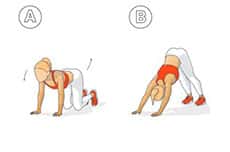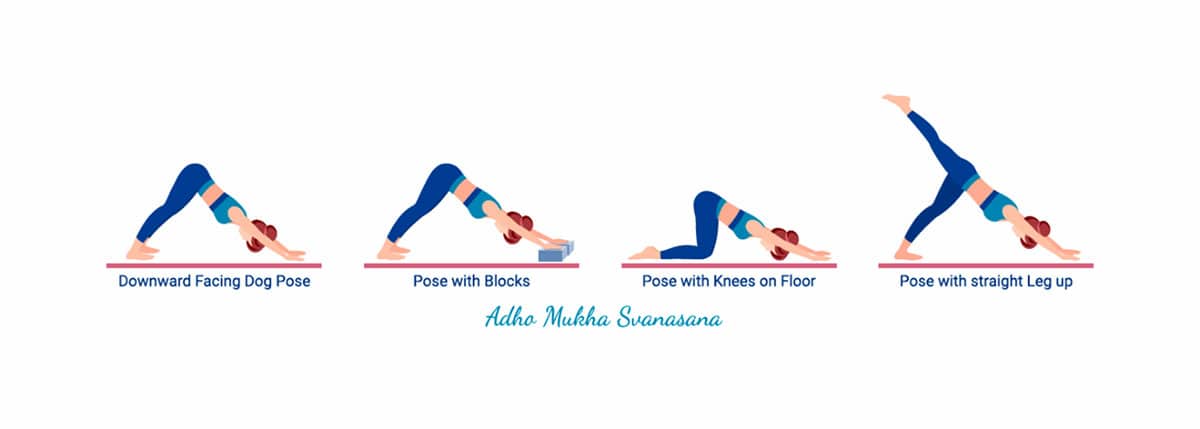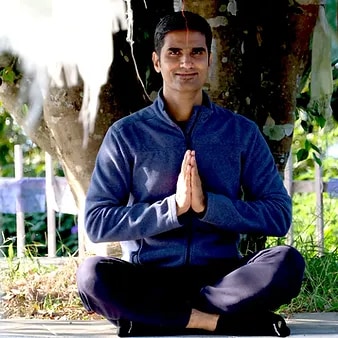Exploring Adho Mukha Svanasana:
The Downward-Facing Dog Pose
by Hardik Mehta

In the world of yoga, few poses are as iconic and versatile as Adho Mukha Svanasana, commonly known as Downward-Facing Dog. This foundational yoga pose offers numerous physical and mental benefits, making it an integral part of yoga practice. In this blog post, we will delve deep into Adho Mukha Svanasana, exploring its technique, benefits, variations, and how to incorporate it into your daily routine.
What is Adho Mukha Svanasana?
Adho Mukha Svanasana, pronounced as “AH-doh MOO-kah shvah-NAH-sah-nah,” is a Sanskrit term that translates to “Downward-Facing Dog Pose.” It is a staple pose in many yoga styles, including Hatha, Vinyasa, and Ashtanga. The pose mimics the shape of a dog stretching itself with its rear end pointing upward and front legs stretched out in front.
How to do Adho Mukha Svanasana?

Starting Position: Begin in a tabletop position with your hands directly under your shoulders and knees under your hips.
Transition: Exhale and lift your hips upward while straightening your legs. Your body should form an inverted “V” shape.
Alignment: Ensure your hands are shoulder-width apart, fingers spread wide for stability, and your feet are hip-width apart. Your heels should ideally reach or lightly touch the ground.
Engagement: Push through your palms and engage your core to lengthen your spine. Feel a stretch through your hamstrings and calves.
Alignment of Head and Neck: Your head should hang freely between your upper arms, and your gaze should be directed towards your navel or the back of your mat.
Breathing: Breathe deeply and evenly. Inhale as you lengthen your spine, and exhale as you deepen the stretch.
Benefits of Adho Mukha Svanasana
Adho Mukha Svanasana offers a wide range of physical, mental, and emotional benefits. Here are some of the key advantages:
Strengthening: This pose engages and strengthens multiple muscle groups, including the shoulders, arms, legs, and core.
Flexibility: Downward Dog stretches the entire back of the body, promoting flexibility in the spine, hamstrings, and calf muscles.
Improves Posture: Regular practice can help improve posture by correcting rounded shoulders and strengthening the back muscles.
Circulation: The inverted position encourages blood flow to the brain, which can enhance mental clarity and reduce stress.
Stress Reduction: Downward Dog is often used as a resting pose in yoga sequences, offering a moment of respite and relaxation.
Digestion: The pose can aid in digestion by massaging the abdominal organs and helping to relieve gas and bloating.
Variations and Modifications

Adho Mukha Svanasana can be adapted to suit your individual needs and abilities. Here are some variations and modifications to consider:
Three-Legged Downward Dog: Lift one leg straight up behind you while in Downward Dog to intensify the stretch on one side.
Puppy Dog Pose: With your hips over your knees, stretch your arms forward and rest your forehead on the ground for a gentle stretch.
Downward Dog on Forearms: Instead of using your hands, perform the pose on your forearms for a more wrist-friendly variation.
Wall-Assisted Downward Dog: Place your hands on a wall to ease into the pose, providing extra support and stability.
Bent Knees Downward Dog: If you are new to the pose, bend your knees slightly to reduce the intensity of the stretch.
Incorporating Adho Mukha Svanasana into Your Routine
To make the most of Adho Mukha Svanasana, it’s essential to incorporate it into your daily or weekly yoga practice. Here is how you can do it:
Warm-Up: Start with a gentle warm-up to prepare your body. Perform some wrist and shoulder stretches to avoid straining these areas during Downward Dog.
Sequence Inclusion: Include Adho Mukha Svanasana in your yoga sequences. It is a versatile pose that can be used as a transition, a resting pose, or a strength-building pose.
Hold and Breathe: When practicing this pose, take your time to hold it for several breaths. This allows your body to fully benefit from the stretch.
Use Props: If needed, use yoga props like blocks or a strap to support your practice.
Contraindications and precautions include:
Wrist Issues: Downward Dog places weight on the wrists, potentially exacerbating conditions like carpal tunnel syndrome or wrist injuries.
High Blood Pressure: The pose can temporarily raise blood pressure, making it risky for individuals with uncontrolled hypertension.
Pregnancy: As pregnancy progresses, modifications are often necessary due to discomfort or instability.
Shoulder Injuries: Those with recent or chronic shoulder injuries, like impingements or rotator cuff issues, should be cautious.
Hamstring Injuries: Overstretching hamstrings can worsen injuries; individuals with hamstring issues must practice with care.
Serious Back Conditions: Severe back issues, such as herniated discs, can be aggravated; consult a healthcare provider or yoga therapist.
Glaucoma: Inversions like Downward Dog can increase eye pressure, a concern for those with glaucoma.
Menstruation: Some women may find it uncomfortable during menstruation; listen to your body.
Hypersensitive Nervous System: For some, inversions can be overstimulating, so choose gentler poses.
Severe Osteoporosis: It is advisable to avoid it due to the risk of fractures from significant weight-bearing on the hands.
Always consult professionals for guidance, adapt the pose to your needs, and if discomfort or pain arises, modify or skip the pose.
Adho Mukha Svanasana, the Downward-Facing Dog Pose, is a cornerstone of yoga practice. Its numerous benefits for the body and mind make it an essential pose for both beginners and experienced yogis. Whether you are seeking strength, flexibility, stress relief, or simply a moment of mindfulness, this iconic pose has you covered. Incorporate it into your routine, explore its variations, and watch as it transforms your yoga journey, helping you find balance and peace in your daily life.
About the Author

Hardik Mehta
Hardik is an E-RYT 500 & YACEP (Yoga Alliance Continuing Education Provider), Yoga Alliance, USA. He has been practicing yoga for the last 9 years. Prior to finding his true calling in Yoga, he was working with various corporates for 12 years in the Retail and eCommerce sector.
